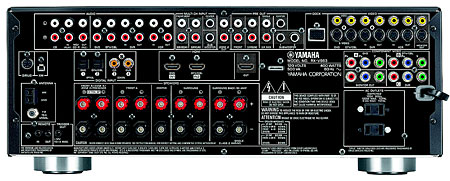Yamaha RX-V663 A/V Receiver Setup & Tests
As I mentioned earlier, the Yamaha RX-V663 has only two HDMI inputs, which is one of its biggest drawbacks. A year ago, this would have been appropriate for an AVR at this price, but some new models now have four HDMI inputs, including the Onkyo TX-SR606 that I recently reviewed for Home Theater. (UAV will publish a separate review of the TX-SR606 soon.) In addition to the pair of HDMI inputs, there are three component inputs along with several S-Video and composite inputs. There are also eight analog input jacks for discrete multichannel sources and eight pre-outs if you prefer to use outboard amplification.
Yamaha's YPAO is a proprietary auto-calibration system, though the basic procedure is the same as all other such systems. Using a supplied microphone, the AVR emits test tones from the speakers, analyzes the data, and determines the size, distance, and levels for all your speakers. Additionally, it sets one of three EQ patterns to provide the best frequency response in your listening space.

Unfortunately, YPAO was not as simple to set up as it should have been. After you plug in the mic and the onscreen menu comes up, there are a few options you need to set before calibration can start. It took me a couple of tries to figure this out, and I'm pretty seasoned when it comes to setting up AVRs. If I find something a tad confusing, I immediately become concerned about the average consumer.
Prior to starting the calibration process, you must select the EQ type—Natural, Flat, or Front—to determine the frequency-response curve associated with the auto setup. I tried two of the EQ types to see how much difference there is between them, starting with the Flat setting. I used "Nothing At All" from Santana's Shaman CD as the reference audio for this part of my testing.
In the Flat mode, center imaging was slightly skewed to the right, and the bass was just too heavy, lacking definition and clarity. Then I redid the auto setup after changing the EQ setting to Natural. Center imaging of the vocals improved, and the bass was smoothed out a bit, but it was still overwhelming. Moving to the seat behind the main "sweet spot," the bass had a more distinct kick, though standing waves became more apparent.
Herein lies one of the main disadvantages of YPAO compared with other auto-setup systems, particularly the Audyssey system found in Denon, Onkyo, and other manufacturers' AVRs. YPAO only balances the system for the sweet spot. Once you leave that position, the sound can change pretty dramatically. Audyssey configures the system for several listening positions, allowing more than one person to enjoy the best possible sound.
Like most auto-setup circuits, YPAO set my main left and right speakers to "large." However, I prefer to set them to "small," sending all low frequencies to the subwoofer, which provides a smoother bass response in my 10x17-foot media room. I set the subwoofer crossover to 80Hz, and the bass was immediately cleaner and tighter in the sweet spot and the back of the room.
Overall, the quality of sound was still somewhat muffled and ill-defined, so I decided to do more manual tweaking to improve performance. I didn't need to change any of the levels or speaker distances, but I wanted some additional control over the EQ. Unfortunately, I could not alter the pre-defined Natural EQ setting, but I was able to switch to the user-adjustable graphic EQ.
Making adjustments primarily to the mid and high frequencies, I got the Santana song to sound more alive and vital. There was greater vocal presence with clearer and more distinct detail of instruments such as the acoustic guitar. However, when I turned up the volume, there was audible distortion. Switching back to the Natural (auto-setup) position, there was less distortion and fewer signs of stress on the amplifier at louder volumes.
I chose not to use the tone controls because they only offer a basic boost and cut (-6dB to +6dB) at 3.5kHz and 350Hz. All frequencies above 3.5kHz and below 350Hz are affected equally, which is not all that useful.
During the course of my review, I never got the RX-V663 to sound exactly as I wanted under all conditions. If my experience is any indication, you may have to experiment quite a bit until you find the settings that work best in your space.
As I mentioned earlier, the V663 offers minimal video processing, so there wasn't much to test in that regard. However, it should be noted that the AVR clips above-white and below-black from video signals passing through it.
- Log in or register to post comments




































































